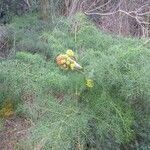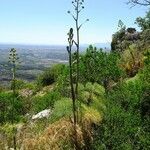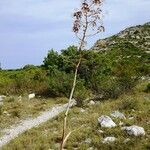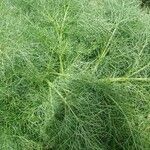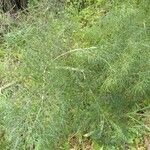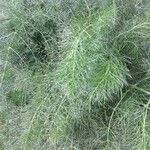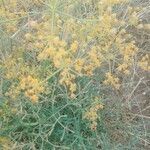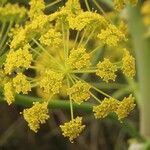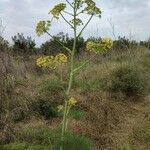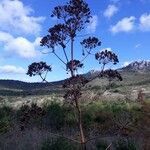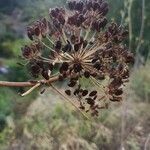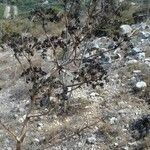Large, glabrous perennial herb ± 0.9–1.8 m., tall, with a stout, solidly pithy stem; stem and branches terete, finely striate.. Basal leaves mostly 4–6, broadly oblong in outline, ± 35–85 × 15–35 cm., tripinnatisect with mostly 6–8 pairs of pinnae, the ultimate segments mucronate, narrowly linear, ± 6–35 × 0.25–1 mm., channelled above, the margins revolute below (frequently to the midrib); sheaths oblong, ± 10–24 cm., narrowing upwards and ± auriculate at the apex; petioles ± 10–18 cm.; lower stem leaves similar but smaller; median stem leaves sessile on the sheaths, deltoid, about as broad as long; inflorescence leaves mostly reduced to narrowly oblong, amplexicaul sheaths which are ± acuminate — the lower firm and green, sometimes with a rudimentary lamina, the uppermost thinner and submembranous; all leaves glabrous.. Umbels numerous, the lower often solitary and unisexual, the upper alternate or opposite, mostly 3 on a common branch with a larger central hermaphrodite umbel and 2 lateral males; terminal umbels in groups of 3 to 5, the central hermaphrodite and the lateral 2–3(–4) ♂; buds arising at anthesis from pairs of concave bracts, the hermaphrodite arising centrally and the males clasped in the bracts. Peduncle of hermaphrodite umbels 0–5.5 cm., of males 2.5–11 cm.; no involucre to either; hermaphrodite umbels with ± 10–25 rays 1.5–5 cm. long; partial umbels ± 10–18-flowered, pedicels 5–12 mm.; involucel absent; ♂ umbels with ± 13–25 rays 1–2.5 cm. long; partial umbels ± 10–25-flowered, pedicels 3–6 mm.; involucel absent or of up to 3 very narrowly linear, tapering bracteoles to ± 3 mm. long.. Calyx distinct, lobes deltoid, acute, ± 0.25 mm., shrivelling and deciduous in fruit.. Petals bright yellow, ovate, glabrous, 1–1.25 mm., with an acute, incurved apex.. Fruit very strongly dorsally compressed, almost flat, broadly obovate to broadly elliptic, ± 10–17 × 5.5–12 mm., primary ribs narrowly prominent; stylopodia depressed, crenate-margined, shortly conical centrally; styles slender, recurved, ± 2 mm.; vittae 3 in each dorsal vallecula, but sometimes reduced to 2 or even 1 in some, or interrupted; commissure 4-vittate.. Fig. 40.
More
A large herb which keeps growing from year to year. It grows 3 m high. It is very robust and has a pungent smell. The stems are stout and hollow. The leaves are divided 3-4 times. They have many bright green thread like lobes. These sheath the base. The upper leaves have smaller blades and larger sheaths. The flower umbels are large and rounded. They are bright yellow-green. The fruit are narrowly oval and flattened. They are 12-15 mm long. They have wings and resin canals.
Woodland, forest glades, rough grassland, pastures, ruderal communities, rocky and stony places, uncultivated land, mountain plain, river banks, pond margins, river beds, olive groves, coastal edges, steep hills; at elevations up to 2,500 metres.
More
It is a Mediterranean plant. It grows in grassy and waste places. It can be in sandy places or on cliffs. Hobart Botanical Gardens.
